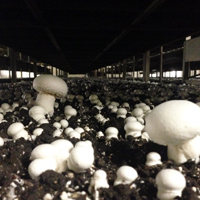Evaluation of energy requirements of an industrial scale plant for the cultivation of white button mushroom (Agaricus bisporus)

Published: 18 June 2020
Abstract Views: 2175
PDF: 2137
HTML: 2376
HTML: 2376
Publisher's note
All claims expressed in this article are solely those of the authors and do not necessarily represent those of their affiliated organizations, or those of the publisher, the editors and the reviewers. Any product that may be evaluated in this article or claim that may be made by its manufacturer is not guaranteed or endorsed by the publisher.
All claims expressed in this article are solely those of the authors and do not necessarily represent those of their affiliated organizations, or those of the publisher, the editors and the reviewers. Any product that may be evaluated in this article or claim that may be made by its manufacturer is not guaranteed or endorsed by the publisher.
Similar Articles
- Canio Manniello, Giuseppe Cillis, Dina Statuto, Andrea Di Pasquale, Pietro Picuno, Experimental analysis on concrete blocks reinforced with Arundo donax fibres , Journal of Agricultural Engineering: Vol. 53 No. 1 (2022)
- Angelo Fabbri, Chiara Cevoli, Giuseppe Cantalupo, A method for handlebars ballast calculation in order to reduce vibrations transmissibility in walk behind tractors , Journal of Agricultural Engineering: Vol. 48 No. 2 (2017)
- Salvatore Faugno, Luisa del Piano, Mariano Crimaldi, Gennaro Ricciardiello, Maura Sannino, Mechanical oil extraction of Nicotiana tabacum L. seeds: analysis of main extraction parameters on oil yield , Journal of Agricultural Engineering: Vol. 47 No. 3 (2016)
- Costanza Di Stefano, Vito Ferro, Establishing soil loss tolerance: an overview , Journal of Agricultural Engineering: Vol. 47 No. 3 (2016)
- G. Riva, E. Foppa Pedretti, G. Toscano, D. Duca, A. Pizzi, M. Saltari, C. Mengarelli, M. Gardiman, R. Flamini, Sustainability of grape-ethanol energy chain , Journal of Agricultural Engineering: Vol. 44 No. s2 (2013): Proceedings of the 10th Conference of the Italian Society of Agricultural Engineering
- Francesco Bettella, Tamara Michelini, Vincenzo D'Agostino, Gian Battista Bischetti, The ability of tree stems to intercept debris flows in forested fan areas: A laboratory modelling study , Journal of Agricultural Engineering: Vol. 49 No. 1 (2018)
- Salahudin Zahedi, Kaka Shahedi, Mahmod Habibnejad Rawshan, Karim Solimani, Kourosh Dadkhah, Soil depth modelling using terrain analysis and satellite imagery: the case study of Qeshlaq mountainous watershed (Kurdistan, Iran) , Journal of Agricultural Engineering: Vol. 48 No. 3 (2017)
- Stefania Pindozzi, Elena Cervelli, Pier Francesco Recchi, Alessandra Capolupo, Lorenzo Boccia, Predicting land use change on a broad area: Dyna-CLUE model application to the Litorale Domizio-Agro Aversano (Campania, South Italy) , Journal of Agricultural Engineering: Vol. 48 No. s1 (2017): Special Issue
- D. dell'Antonia, S.R.S. Cividino, A. Carlino, R. Gubiani, G. Pergher, Development perspectives for biogas production from agricultural waste in Friuli Venezia Giulia (Nord-East of Italy) , Journal of Agricultural Engineering: Vol. 44 No. s2 (2013): Proceedings of the 10th Conference of the Italian Society of Agricultural Engineering
- Bhola Paudel, Jayanta Kumar Basak, Seong Woo Jeon, Gun Ho Lee, Nibas Chandra Deb, Sijan Karki, Hyeon Tae Kim, Working speed optimization of the fully automated vegetable seedling transplanter , Journal of Agricultural Engineering: Vol. 55 No. 2 (2024)
<< < 11 12 13 14 15 16 17 18 19 20 > >>
You may also start an advanced similarity search for this article.

 https://doi.org/10.4081/jae.2020.1000
https://doi.org/10.4081/jae.2020.1000






